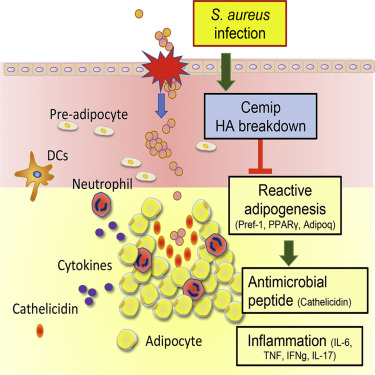Our official English website, www.x-mol.net, welcomes your
feedback! (Note: you will need to create a separate account there.)
Hyaluronan Degradation by Cemip Regulates Host Defense against Staphylococcus aureus Skin Infection.
Cell Reports ( IF 7.5 ) Pub Date : 2020-01-07 , DOI: 10.1016/j.celrep.2019.12.001 Tatsuya Dokoshi 1 , Ling-Juan Zhang 1 , Fengwu Li 1 , Teruaki Nakatsuji 1 , Anna Butcher 1 , Hiroyuki Yoshida 2 , Masayuki Shimoda 3 , Yasunori Okada 4 , Richard L Gallo 1
Cell Reports ( IF 7.5 ) Pub Date : 2020-01-07 , DOI: 10.1016/j.celrep.2019.12.001 Tatsuya Dokoshi 1 , Ling-Juan Zhang 1 , Fengwu Li 1 , Teruaki Nakatsuji 1 , Anna Butcher 1 , Hiroyuki Yoshida 2 , Masayuki Shimoda 3 , Yasunori Okada 4 , Richard L Gallo 1
Affiliation

|
Staphylococcus aureus is a major human bacterial pathogen responsible for deep tissue skin infections. Recent observations have suggested that rapid, localized digestion of hyaluronic acid in the extracellular matrix (ECM) of the dermis may influence bacterial invasion and tissue inflammation. In this study we find that cell migration-inducing protein (Cemip) is the major inducible gene responsible for hyaluronan catabolism in mice. Cemip-/- mice failed to digest hyaluronan and had significantly less evidence of infection after intradermal bacterial challenge by S. aureus. Stabilization of large-molecular-weight hyaluronan enabled increased expression of cathelicidin antimicrobial peptide (Camp) that was due in part to enhanced differentiation of preadipocytes to adipocytes, as seen histologically and by increased expression of Pref1, PPARg, and Adipoq. Cemip-/- mice challenged with S. aureus also had greater IL-6 expression and neutrophil infiltration. These observations describe a mechanism for hyaluronan in the dermal ECM to regulate tissue inflammation and host antimicrobial defense.
中文翻译:

Cemip的透明质酸降解可调节宿主防御金黄色葡萄球菌皮肤感染的能力。
金黄色葡萄球菌是引起深部组织皮肤感染的主要人类细菌病原体。最近的观察表明,真皮细胞外基质(ECM)中透明质酸的快速,局部消化可能会影响细菌的入侵和组织炎症。在这项研究中,我们发现细胞迁移诱导蛋白(Cemip)是负责小鼠透明质酸分解代谢的主要诱导基因。Cemip-/-小鼠未能消化透明质酸,在金黄色葡萄球菌对皮内细菌的攻击后,感染的证据明显减少。大分子透明质酸的稳定化使cathelicidin抗菌肽(Camp)的表达增加,这部分是由于组织学上观察到的前脂肪细胞向脂肪细胞的分化增强以及Pref1,PPARg,和Adipoq。用金黄色葡萄球菌攻击的Cemip-/-小鼠也具有更高的IL-6表达和中性粒细胞浸润。这些观察结果描述了真皮ECM中透明质酸调节组织炎症和宿主抗微生物防御的机制。
更新日期:2020-01-07
中文翻译:

Cemip的透明质酸降解可调节宿主防御金黄色葡萄球菌皮肤感染的能力。
金黄色葡萄球菌是引起深部组织皮肤感染的主要人类细菌病原体。最近的观察表明,真皮细胞外基质(ECM)中透明质酸的快速,局部消化可能会影响细菌的入侵和组织炎症。在这项研究中,我们发现细胞迁移诱导蛋白(Cemip)是负责小鼠透明质酸分解代谢的主要诱导基因。Cemip-/-小鼠未能消化透明质酸,在金黄色葡萄球菌对皮内细菌的攻击后,感染的证据明显减少。大分子透明质酸的稳定化使cathelicidin抗菌肽(Camp)的表达增加,这部分是由于组织学上观察到的前脂肪细胞向脂肪细胞的分化增强以及Pref1,PPARg,和Adipoq。用金黄色葡萄球菌攻击的Cemip-/-小鼠也具有更高的IL-6表达和中性粒细胞浸润。这些观察结果描述了真皮ECM中透明质酸调节组织炎症和宿主抗微生物防御的机制。










































 京公网安备 11010802027423号
京公网安备 11010802027423号